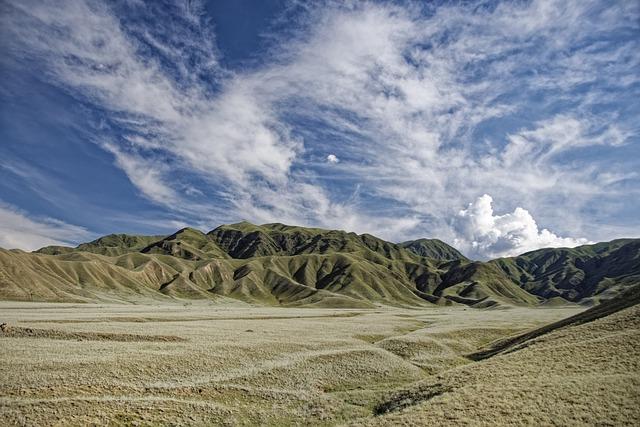Building a Water-Secure Future in Central Asia: The World Bank Group’s Vision
As Central Asia grapples with the escalating challenges of climate change, population growth, adn outdated infrastructure, the region’s water security has emerged as a pressing concern that affects millions. With rivers and aquifers that transcend national borders, the need for collaborative management and sustainable practices has never been more urgent. The World Bank Group, recognizing the critical role water plays in economic development and social stability, has launched complete initiatives aimed at confronting these challenges head-on. This article delves into the World Bank’s multifaceted approach to enhancing water security in Central Asia, highlighting innovative strategies, regional cooperation, and the imperative of sustainable resource management to ensure that communities thrive in harmony with their vital water resources.
Understanding Central Asia’s Water Crisis
The water crisis in Central Asia has emerged as a pressing challenge, exacerbated by a combination of climatic changes, outdated infrastructure, and geopolitical tensions. As the region grapples with diminishing water resources,the impact is felt across various sectors,including agriculture,energy,and public health. Communities that rely heavily on river basins such as the Aral Sea and the Amu Darya face severe water shortages, threatening livelihoods and exacerbating existing social inequalities. The confluence of these factors demands urgent attention and coordinated efforts to develop sustainable management practices that can mitigate the crisis.
Key contributing factors to the water crisis include:
Diminishing glacial reserves: Climate change is reducing the volume of glaciers that feed into major rivers.
Inefficient irrigation practices: Traditional farming methods drain water without effectively supporting crop needs.
Pollution from industrial runoff: Contamination of water sources complicates access to clean water.
Geopolitical disputes: Tensions between neighboring countries over water rights hinder collaborative management efforts.
To address these multifaceted challenges, regional cooperation is essential. Initiatives aimed at enhancing water management, investing in modern infrastructure, and promoting water-saving technologies can pave the way for a resilient future. The World Bank Group aims to facilitate dialog among stakeholders and provide the necessary resources for sustainable development, ensuring that water security becomes a cornerstone of regional stability.
Impact of climate Change on Regional Water Resources
The repercussions of climate change are significantly altering the landscape of water resources in Central Asia, a region already grappling with water scarcity issues. Rising temperatures, shifting precipitation patterns, and the melting of glaciers are altering runoff patterns and diminishing the reliability of water supplies. The following consequences are especially pronounced:
Decreased Glacial Melt: Glaciers, which serve as natural reservoirs, are receding rapidly, leading to a projected decline in seasonal water availability.
Changing Rainfall Patterns: Increased unpredictability in rainfall not only affects agriculture but also puts added pressure on already strained water infrastructure.
Increased Evaporation: Higher temperatures lead to accelerated evaporation rates from lakes and rivers, further reducing water availability.
The shift in regional water dynamics threatens not only the livelihoods of millions but also international relations,as riparian states navigate disputes over dwindling resources. Table 1 below illustrates the projected changes in key water supply indicators over the next decade:
Indicator
Current Status
Projected Change by 2030
Annual Precipitation (mm)
400-600
-10%
Glacial Mass (cubic km)
80
-25%
Surface Water Availability (billion m³)
200
-15%
Innovative Solutions for Sustainable Water Management
With the escalating challenges posed by climate change and population growth, the need for innovative solutions in water management has never been more urgent. central Asia, a region characterized by arid landscapes and limited freshwater resources, is at the forefront of adopting cutting-edge technologies and practices that enhance water security. This includes the implementation of smart irrigation systems, which utilize sensors and data analytics to optimize water usage in agriculture, minimizing waste while maximizing crop yields. Additionally, the promotion of rainwater harvesting techniques offers a sustainable approach to capturing and storing precipitation for use during dry seasons, directly benefiting local communities.
Partnerships between governments, NGOs, and private sectors are crucial in fostering a culture of sustainable water practices. One noteworthy initiative is the integration of cloud-based monitoring systems, which provide real-time data on water quality and availability across municipalities. These systems allow for better planning and resource allocation, ensuring that water remains accessible to all citizens. moreover, investment in desalination technologies can provide alternative sources of freshwater in regions bordering seas and oceans, reducing reliance on conventional water sources and safeguarding against potential shortages.
Strengthening Regional Cooperation and Governance
Effective governance and regional collaboration are essential for addressing water management challenges in Central Asia. the world Bank Group emphasizes the importance of establishing platforms for dialogue and cooperation among the diverse nations in the region. By fostering mutual understanding and encouraging the sharing of best practices, countries can enhance their capacities for sustainable water use. This engagement can lead to the formulation of integrated approaches that address the needs of various stakeholders, including farmers, industries, and urban populations.
To achieve long-lasting solutions, several key strategies can be employed:
Capacity Building: Strengthening institutional frameworks and enhancing technical expertise.
data Sharing: Promoting transparency and knowledge exchange through shared water data and resources.
joint Management: Developing cross-border water management agreements to ensure equitable distribution of water resources.
Community Engagement: involving local communities in decision-making processes to ensure that their voices are heard.
The importance of governance structures cannot be understated,as they play a crucial role in mediating conflicts and ensuring the fair allocation of water resources across borders. Collaborative initiatives can lay the groundwork for sustainable water management practices that not only address immediate challenges but also prepare for future demands.
Investment Strategies for Water Infrastructure Development
To effectively address the pressing challenges facing water infrastructure in Central Asia, a multifaceted investment approach is essential. public-private partnerships (PPPs) can harness the strengths of both sectors,maximizing resources and fostering innovation in water project execution. By incentivizing private investment, local governments can enhance service delivery while ensuring accountability. Integrated financing models that combine grants, loans, and equity investments are crucial for developing sustainable water projects. These models can help leverage international funding sources while ensuring financial viability through cost-recovery mechanisms and efficient resource management.
As Central Asia’s water crisis grows, strategic investments must emphasize both upgrading existing infrastructure and innovating new solutions. Key strategies include:
Decentralization: Empowering local governments to manage water resources can lead to more responsive and targeted interventions.
Technology adoption: implementing digital tools for monitoring and management can significantly improve water efficiency.
Capacity building: Investing in human capital ensures that local stakeholders have the necessary skills to sustain water infrastructure improvements.
Collaborative efforts among international organizations, regional governments, and local communities will be fundamental in driving these investments forward, paving the way for a more resilient and water-secure future.
Empowering Local Communities through Capacity Building
In Central Asia, empowering local communities is crucial for building resilience against water scarcity and ensuring sustainable management of this vital resource. Through various initiatives, stakeholders are collaborating to enhance local capacities, equipping individuals with the knowledge and tools necessary to effectively address water-related challenges. some key strategies include:
Training Workshops: Engaging community members in educational programs that focus on water conservation techniques and sustainable practices.
Resource Sharing: Facilitating partnerships among local entities to share best practices and innovations in water management.
Local Leadership Development: Encouraging community members to take on leadership roles, promoting a sense of ownership in water governance.
moreover, capacity building goes hand-in-hand with fostering inclusive governance structures that promote active participation. Regional workshops and community forums serve as platforms where local voices can be heard, creating a dialogue that enhances decision-making processes. A recent workshop in Uzbekistan, as an example, gathered diverse stakeholders to address the following:
Topic
Stakeholders Involved
Outcome
Water Quality Monitoring
Local NGOs, Goverment Agencies
action Plan Developed
Community Water Storage Solutions
Farmers, local Authorities
Pilot Projects Initiated
Public Awareness Campaigns
Schools, Community Leaders
Increased Engagement
These initiatives illustrate a commitment to not only enhancing immediate responses to water challenges but also creating a foundation for long-term sustainability. By fostering interconnectedness among communities, they can collectively strive towards a water-secure future, balancing immediate needs with strategic planning for generations to come.
In Conclusion
as Central Asia grapples with the profound challenges of water scarcity and climate change, the World Bank Group’s initiatives underscore the essential need for collaborative solutions that prioritize sustainability and resilience. The strides taken thus far highlight the importance of not only investing in infrastructure but also fostering regional cooperation and innovation. with water resources under increasing strain, it is imperative that governments, communities, and organizations work together to develop strategies that safeguard this vital resource for future generations. By embracing a comprehensive approach to water security, Central Asia can pave the way for a more sustainable, prosperous future—one where access to water is not just a privilege but a right for all. As we move forward, the commitment to building a water-secure future will be crucial in ensuring the health, livelihood, and resilience of the region amidst an ever-changing global landscape.
Author : Asia-News
Publish date : 2025-02-24 12:36:28
Copyright for syndicated content belongs to the linked Source.






